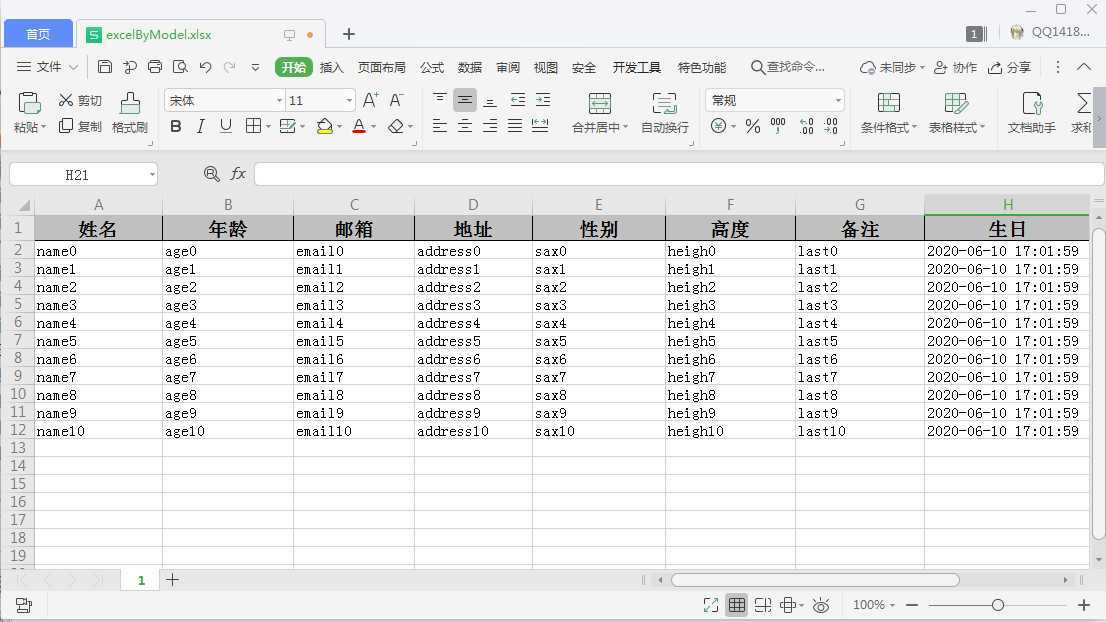读取excel文件解析为实体对象列表
例:将如下文件解析为List<Object>

将该文件内容转换为List<User>
继承了BaseRowModel,字段上添加@ExcelProperty注解,属性value表示表头名,index表示列的顺序排序
package com.harara.model; import com.alibaba.excel.annotation.ExcelProperty; import com.alibaba.excel.metadata.BaseRowModel; import lombok.Data; import java.util.Date; /** * @author : harara * @version : 2.0 * @date : 2020/6/9 15:32 * 继承BaseRowModel */ @Data public class User extends BaseRowModel{ @ExcelProperty(value = "姓名", index = 0) private String name; @ExcelProperty(value = "年龄", index = 1) private String age; @ExcelProperty(value = "邮箱", index = 2) private String email; @ExcelProperty(value = "地址", index = 3) private String address; @ExcelProperty(value = "性别", index = 4) private String sax; @ExcelProperty(value = "高度", index = 5) private String heigh; @ExcelProperty(value = "备注", index = 6) private String last; @ExcelProperty(value = "生日",index = 7) private Date bitthday; }
继承AnalysisEventListener
package com.harara.easyexcel.read; import com.alibaba.excel.context.AnalysisContext; import com.alibaba.excel.event.AnalysisEventListener; import java.util.ArrayList; import java.util.List; /** * @author : harara * @version : 2.0 * @date : 2020/6/10 9:25 */ public class ExcelListener extends AnalysisEventListener { private List<Object> dataList = new ArrayList<Object>(); /** * 通过AbalysisContext可以获取当前sheet,当前行等数据 * @param object * @param context */ @Override public void invoke(Object object, AnalysisContext context) { dataList.add(object); } @Override public void doAfterAllAnalysed(AnalysisContext context) { //dosomething } public List<Object> getDataList(){ return dataList; } }
读取excel文件解析为实体对象列表
package com.harara.easyexcel.read; import com.alibaba.excel.ExcelReader; import com.alibaba.excel.event.AnalysisEventListener; import com.alibaba.excel.metadata.BaseRowModel; import com.alibaba.excel.metadata.Sheet; import com.alibaba.excel.support.ExcelTypeEnum; import com.harara.model.User; import java.io.File; import java.io.FileInputStream; import java.io.InputStream; import java.util.ArrayList; import java.util.List; /** * @author : harara * @version : 2.0 * @date : 2020/6/10 9:41 */ public class ExcelReadTest { public <T extends BaseRowModel> List<T> read(String filename, Class<T> rowModel) throws Exception{ ExcelListener excelListener = new ExcelListener(); ExcelReader excelReader = getExcelReader(new File(filename),excelListener,true); if(excelReader == null){ return new ArrayList(); } for(Sheet sheet:excelReader.getSheets()){ sheet.setClazz(rowModel); excelReader.read(sheet); } List<T> list = new ArrayList<>(); for(Object obj:excelListener.getDataList()){ list.add((T)obj); } return list; } /** * * @param file 文件 * @param eventListener 用户监听器 * @return */ public static ExcelReader getExcelReader(File file, AnalysisEventListener eventListener) throws Exception{ String fileName = file.getName(); if (fileName == null ) { throw new Exception("文件格式错误!"); } if (!fileName.toLowerCase().endsWith(ExcelTypeEnum.XLS.getValue()) && !fileName.toLowerCase().endsWith(ExcelTypeEnum.XLSX.getValue())) { throw new Exception("文件格式错误!"); } InputStream inputStream = null; try{ inputStream = new FileInputStream(file); if (fileName.toLowerCase().endsWith(ExcelTypeEnum.XLS.getValue())) { return new ExcelReader(inputStream, ExcelTypeEnum.XLS, null, eventListener, false); } else { return new ExcelReader(inputStream, ExcelTypeEnum.XLSX, null, eventListener, false); } }catch (Exception e){ e.printStackTrace(); return null; } } public static void main(String[] args) { ExcelReadTest excelReadTest = new ExcelReadTest(); try { List<User> users = excelReadTest.read("excelByModel.xlsx", User.class); System.out.println(users); System.out.println("读取完成"); }catch (Exception e){ e.printStackTrace(); } } }
原文:https://www.cnblogs.com/kiko2014551511/p/13086949.html